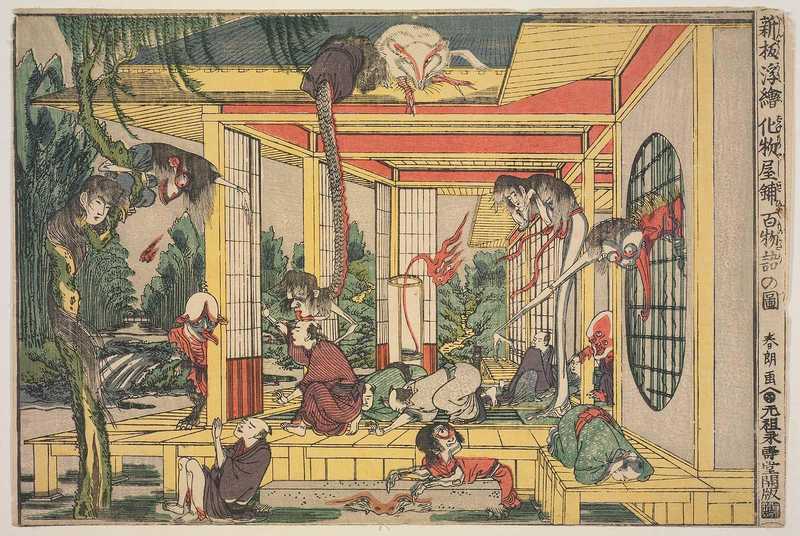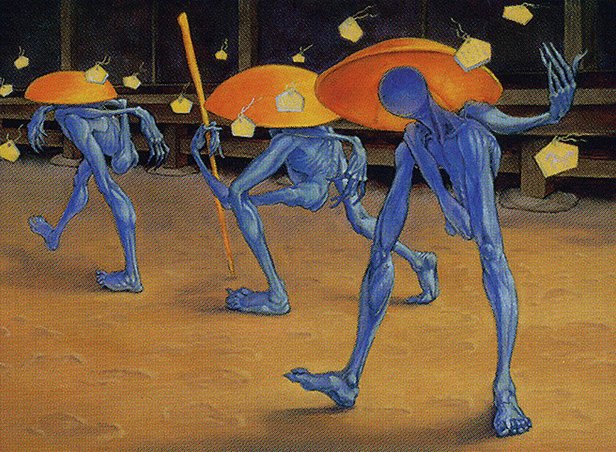Retro Reviews
Kamigawa and The New York Yankees
My prior retro reviews evaluated the mechanics of old Magic sets, but when I set my sights on 2004’s Champions of Kamigawa, it required a change of approach. For one thing, its mechanics are largely rancid. Glacial Ray and other Splice create budget Punishing Fire locks, Spirits-vs-everyone is a underpowered hatefest, and all the legends are awesome for their cool factor rather than any special gameplay.
My next plan was to talk about Kamigawa’s flavor, but then I moved to Japan,1 where I was ambushed by the realization that Kamigawa has nearly zero original flavor. My Japanese is atrocious, but even I can see that a daisho literally means a samurai’s paired swords; that bonshō bells and torii (the gates that are Champions’ set symbol) are in every neighborhood; that kami are the little-g gods or essences said to reside in everything from inanimate objects to people and weather events.
Even Kamigawa’s evocative, deeply weird art, which I’ve loved for as long as I’ve played Magic, has centuries of Japanese precedent, where ukiyo-e masters like Hokusai and Kuniyoshi created mass-produced prints of wise fox-people and eerie ghost stories:

There’s also a Japanese folk figure named the Hell Courtesan, who in 1880 already had more panache than the next 145 years combined. I was so ready to praise Kamigawa’s deep, original imagination, but now it seems its originality existed only in comparison to my ignorance. What comes next?
The Worst Thing About Tokyo
Tokyo is, they say, a tourist’s dream: omnipresent convenience stores, revolutionary public transit, reasonably priced and high-quality clothing in staggering variety. I strongly disagree about the last part, because for some reason, it’s impossible to buy a baseball cap in Earth’s largest city that isn’t marred by the hideous logos of either the New York Yankees or the LA Dodgers. Where are my Philadelphia Phillies (oldest continuously-named team in US sports, soon-to-be 2025 World Series Champs)? Where are the Athletics, the Cubs, the Orioles?2 I would even accept the Brooklyn Dodgers! Japan clearly has the good sense to sort municipal garbage into burnable, non-burnable, and Red Sox merch, so what’s with this unearned glazing of baseball’s most boring overdogs?
The serious answer, of course, is that people buy shit to signal social status, and New York and Los Angeles are prestigious because they are the largest cities in humanity’s richest country, a country that has spent 80 years as Earth’s primary hegemon. America took the final step up to its imperial dias in 1945 when we subjugated our allied empires with wartime loans and our enemies with civilian-tested atomic weaponry. The Japanese Empire, once tyrants of Korea and parts of China and the Pacific Rim, fared no better than the rest.
Before the ashes of Tokyo had begun to cool, before the radioactive isotopes had faded from the civilian cities of southern Japan, American general Douglas MacArthur assumed control over the Japanese Empire. From 1945-1952, during what Japan calls the post-war Shōwa period, Americans occupied Japan and literally rewrote its constitution. This legacy, too, is inescapably obvious to a visitor of Japan. The art museum is divided into “before and after American occupation;” English translations appear on every public sign; the largest US military base outside our borders shadows the beaches of Okinawa. I’m writing this piece in a city whose civilians have known bombardment by American battleships.
And yet, though America has often imposed unequal power on Japan, the cultural relationship is far more complex than one-way domination. For example, partly in response to 19th-century imperial pressures, Japanese painters began to emulate Western ones, the mirror of van Gogh’s and Monet’s japonisme, but the resulting art is no less unique or stunning. American mid-century staples like baseball, hot dogs, and Snoopy are all outrageously popular among Japanese citizens, well-represented on every subway car and konbini shelf. And the clothes! Though contemporary Japanese menswear looked to Ralph Lauren and Brooks Brothers as its inspiration in the 1960s, America soon got lured by globalized manufacturing and neon nylon, so that now, the situation is reversed. Ralph and Messrs. Brooks wish they had one thread’s worth of Japanese textile quality, craft, and favorable social conditions.
Reclaiming Appropriated Cards
Cultural appropriation is when an object gets taken out-of-context, with a power imbalance or a profit motive, or without curiosity for the background culture. It’s totally possible to exchange cultural objects in a healthy way. Nippon Professional Baseball may be a for-profit company, but its first pitch was thrown in 1949 out of a genuine desire to participate in an awesome sport. The crazy hot-dog burrito I bought today (tortilla, barbeque sauce, no other condiments) isn’t disrespectful, because it’s obviously awesome and delicious and cost only ¥268. And so on.
Magic’s Kamigawa is, I think, a little more mixed. Champions of Kamigawa was described by its designers as “Shintō gone wrong,” a set based in ”Japanese mythology.” But Shintō is not myth. Shintō is a contemporary, ubiquitous, real-world religion of Japan, and the kami are its peaceful, natural, non-anthropocentric objects of veneration.3 It’s like making a set about Henry VIII rejecting Catholicism, printing a hundred-odd cards with blood-frocked priests and vengeful nuns, and slapping on a cruciform set symbol just in case someone didn’t get the joke. Some of Wizards’ references were factually incorrect, too, from an O-Naginata depicted as a sword rather than a polearm, to errors or inaccuracies around the usage of religious words.
Kamigawa’s 2004 release predates the adoption of social media or the mainstream Western acceptance of anime, so many Americans didn’t know Shintō except through Champions’ ersatz mirror. Though Kamigawa’s creators adopted as honestly and faithfully as they could, the game of Magic always requires stories with a violent conflict and a five-way personality test, stories in service of WotC’s profit motives, and that means you sometimes have to resize the foot to fit the shoe. Even if it ain��’t cultural appropriation, it’s cringe as heck, and that might be even worse.
But this critique only extends to the corporation and its product. We humans, on the other hand, are not judged only on what we consume. Tokyo’s commuters shouldn’t be held responsible for the LA Dodgers’ astroturfing campaign, and neither should Western Magic players be held responsible for WotC. We can reclaim cringe Kamigawa cards when we engage with them as curious learners rather than status-seeking consumers. Yes, I was ignorant about the rich history and culture behind Kamigawa, but ignorance is nothing to be ashamed of. It is instead something to grow past. When struggling to communicate in Japanese, don’t give up or insist on English. Say isshōkenmei: I am trying my best.
This fall, I’m rewatching the films of Hayao Miyazaki, charmed by Magic’s reflections of the bustling onsen of Spirited Away, the kodama tree guardians of Mononoke, and the ecological harmony of Nausicaä. I’ve sought out a roadside reliquary (more properly called a hokura) atop the mountain that overlooks my apartment. I’ve loved learning about the royal women in Tokyo’s palace, deepening my empathy for Michiko Konda, Truth Seeker in Kamigawa’s story. It’s even been fun to use Kamigawa to boost my Japanese vocabulary (albiet in oddly specific and bellicose circumstances).
You may be wondering what Japanese folks think of Kamigawa. So am I. I find it somewhat unlikely that Japanese gamers think of Kamigawa any more than I think about the Yanks.4 Magic simply doesn’t seem to matter very much in Tokyo; the convenience stores only sell One Piece TCG and Pokémon jammed between drinks and hot-dog concoctions. If I do meet anybody, though, I’ll be sure to ask them ”氷河の光線は愚かですか?”
- Yes, I’ll return to the land of private healthcare and Big Macs soon, but for now I’m paying rent and utilities in ¥ instead of $, and I have even been counted in the national census. Let me have this fleeting happiness.↩
- Okay, occasinally I’ll see hats for the Padres and the Tigers, which at least have some style.↩
- Shintō and Buddhism have both existed in Japan for roughly a millenium-plus, but with syncretic exchanges of belief and practice at least until the Meiji era (late 1800s).↩
- Which is to say: of course I wish the Yankees ill every time I think of them, but I would never go to any inconvenience.↩
